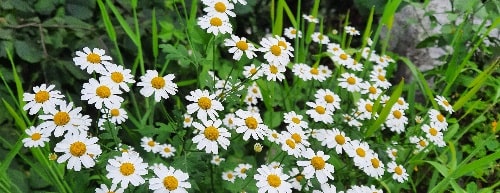Why do daisies grow on roadsides in America?
Because wild chamomile is a wild flower that grows everywhere: on roadsides, in lawns and fields, on personal plots. It contains beneficial substances that are used to treat childhood and adult ailments. When and in which month do daisies bloom? The buds begin to bloom in spring and bloom until late fall. The core of the flower is a basket with numerous mini-flowers collected in a yellow center. Each tubercle in the yellow basket of the core is a full-fledged flower that can independently pollinate and give seeds. The white petals are also separate small flowers, only sterile. Each of these consists of sharp tongues, which the flower needs to attract insects for pollination.
The daisy lives one season before the onset of winter, an annual plant. At the first big frosts the plant dies; with the onset of spring new daisies grow from seeds sown. Daisies (genus Leucanthemum) are often found growing on roadsides in America and in various other regions. There are a few reasons why daisies may thrive in roadside environments:
- Disturbed Soil: Roadsides are typically areas of disturbed soil. Construction and maintenance activities, such as grading, digging, or compacting the soil, can create favorable conditions for daisy seeds to germinate. Disturbed soil provides an opportunity for the daisy seeds to establish and grow, as it can be more receptive to seed germination compared to undisturbed soil.
- Open Sunlight: Many daisy species prefer full sunlight for optimal growth. Roadsides often offer open, sunny conditions as vegetation along roadsides is regularly trimmed or mowed, keeping the area relatively free from shading vegetation. Daisies benefit from the abundance of sunlight in these locations.
- Minimal Competition: Roadside environments may have less competition from other plants compared to natural habitats or more densely vegetated areas. The regular maintenance and mowing of roadsides can reduce the growth of taller plants, giving daisies a competitive advantage in accessing sunlight and other resources.
- Tolerance to Disturbed Conditions: Some daisy species, such as the common daisy (Leucanthemum vulgare), have adapted to tolerate and even thrive in disturbed environments. They have the ability to establish and grow in areas with less-than-ideal soil conditions and disturbances.

It’s important to note that roadside daisies can have both positive and negative impacts. They contribute to the visual beauty of roadsides, offering bursts of white and yellow flowers. However, in some cases, they can also be considered invasive or problematic when they spread into natural habitats or compete with native plant species.
Local regulations and management practices can vary regarding roadside vegetation. Some areas may actively manage roadside vegetation to promote native species, reduce invasives, or address safety concerns. It is always important to follow local guidelines and regulations when considering roadside vegetation management.
Do daisy flowers grow everywhere in America?
Daisy flowers (genus Leucanthemum) are native to Europe and Asia, but they have been introduced and naturalized in many parts of North America. While daisies can be found in various regions across America, their distribution may not be uniform throughout the entire country. Several factors can influence where daisy flowers grow, including climate, soil conditions, and local ecological factors.
Daisy species, such as the common daisy (Leucanthemum vulgare) or the oxeye daisy (Leucanthemum leucanthemum), are widespread and can be found in many states across the United States. They are often considered naturalized or invasive in certain regions due to their ability to establish and spread outside their native range.
However, it’s important to note that not all daisy species are equally distributed or abundant in every part of America. Native daisy species, such as the American daisy (Hymenoxys herbacea), may have more restricted distributions or be specific to certain regions, such as the western United States.
The presence and abundance of daisy flowers can also be influenced by local environmental conditions and land management practices. Factors like climate, altitude, soil type, moisture levels, and human activities can all impact the occurrence and prevalence of daisies in different regions of America.
If you’re interested in identifying and learning about the specific daisy species in a particular area, local field guides, botanical resources, or native plant societies can provide more specific information based on your region of interest.
In which states can daisies grow in America?
Daisies can grow in various states across America, as they are adaptable plants that can thrive in different climates and conditions. Here is a general overview of the states where daisies can grow:
- Northeast Region: Daisies can be found in states like Maine, New Hampshire, Vermont, Massachusetts, Rhode Island, Connecticut, New York, Pennsylvania, New Jersey, and Delaware.
- Mid-Atlantic Region: Daisies can grow in states such as Maryland, Virginia, West Virginia, and Washington, D.C.
- Southeast Region: Daisies can be found in states like North Carolina, South Carolina, Georgia, Florida, Alabama, Mississippi, Tennessee, Kentucky, and Louisiana.
- Midwest Region: Daisies can grow in states such as Ohio, Indiana, Illinois, Michigan, Wisconsin, Minnesota, Iowa, Missouri, Kansas, Nebraska, North Dakota, and South Dakota.
- Great Plains Region: Daisies can be found in states like Montana, Wyoming, Colorado, New Mexico, Texas, Oklahoma, and parts of Kansas, Nebraska, and South Dakota.
- Southwest Region: Daisies can grow in states such as Arizona, Utah, Nevada, and parts of New Mexico and Colorado.
- West Coast Region: Daisies can be found in states like California, Oregon, Washington, and parts of Alaska and Hawaii.
It’s important to note that specific daisy species may have different native ranges within these states, and some species may be more prevalent in certain regions. The diverse geography and climates across the United States provide suitable habitats for various daisy species.





